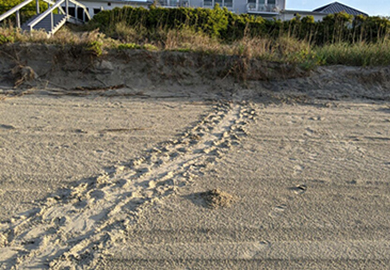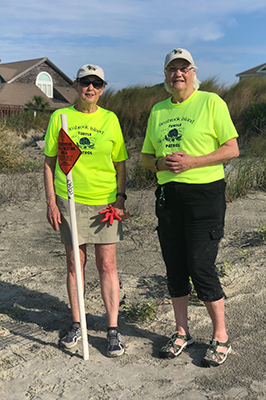SCDNR News
South Carolina marks first sea turtle nest of the year
May 5, 2021

CHARLESTON COUNTY, S.C. — While sea turtle volunteers have been walking South Carolina’s beaches in search of nests since May 1, the official start of the season, it wasn’t until this morning that they found something to count.
South Carolina Department of Natural Resources (SCDNR) biologists and volunteers are excited to announce that a mother loggerhead laid the first nest of the season sometime last night on Seabrook Island. Volunteers Sandy MacCoss and Lucy Hoover spotted a crawl and located the nest on the island 20 miles south of Charleston.
"Our staff and nest protection volunteers have been eagerly awaiting the arrival of the season’s first nest marking the return of these ancient reptiles," said SCDNR biologist Michelle Pate, who oversees the agency's sea turtle nesting program. "We're hopeful for a great season under the watchful eyes of our dedicated volunteer network members."
Despite the complications of the 2020 season, which ranged from beach closures to ongoing COVID-19 restrictions, it was a successful nesting year for South Carolina’s sea turtle population, with 5,560 nests laid. Because nesting exacts a high energy toll on the large reptiles, female sea turtles do not come ashore to lay eggs every year. This pattern results in nesting fluctuations from year to year – 2019 broke all records with 8,795 nests, but 2018 saw just 2,767 nests.
Overall, sea turtle nest numbers across the Southeast have trended up over the past decade, making biologists across the region optimistic that these threatened reptiles are beginning to recover after several decades of conservation efforts.
Four sea turtle species nest on South Carolina beaches: loggerheads, greens, Kemp’s ridleys, and leatherbacks. All four species are classified as endangered or threatened and are protected under the Endangered Species Act in addition to local and state ordinances. Loggerhead nests comprise the vast majority of the state’s total number each year, but 2020 saw at least one nest from each species and even five nests from a loggerhead-hawksbill hybrid.
Sea turtle season officially runs from May 1 through October 31, with hatching beginning around the start of July.
Sea turtle clutches average 120 eggs and hatch after approximately 60 days. Nesting females may remain in South Carolina waters and continue to nest every two weeks, laying up to six nests per season. Throughout this stressful time, the turtles also abstain from eating.
South Carolina beachgoers can help the state’s sea turtles by keeping beaches clean, turning beachfront lights out to avoid disorienting turtles, and giving all sea turtles and nests a wide and respectful berth when encountered on the beach.

- Report all sick/injured/dead sea turtles and nest disturbances to the SCDNR at 1-800-922-5431 so that staff/volunteers can respond as soon as possible.
- Respect boating laws and boat cautiously, especially in small tidal creeks where sea turtles like to feed. Boat strikes have emerged as the leading cause of death for sea turtles in South Carolina.
- Keep artificial lights off the beach at night during nesting season – this includes beachfront property lights and flash photography, which can disorient nesting mothers and hatchlings.
- Always respect sea turtles by observing them from a distance on the beach. Individuals that violate federal law by harming or interfering with sea turtles or their nests can be subject to civil penalties of up to $25,000 and up to a year’s imprisonment.
- Keep our beaches and ocean clean by avoiding single-use plastics. Plastic bags and balloons are among the most common trash items found on South Carolina beaches and can cause injury or death when sea turtles mistake them for food.
- Promote and support our program for continued conservation of sea turtles in South Carolina.
For additional information, contact:
Erin Weeks
(843) 729-3531



